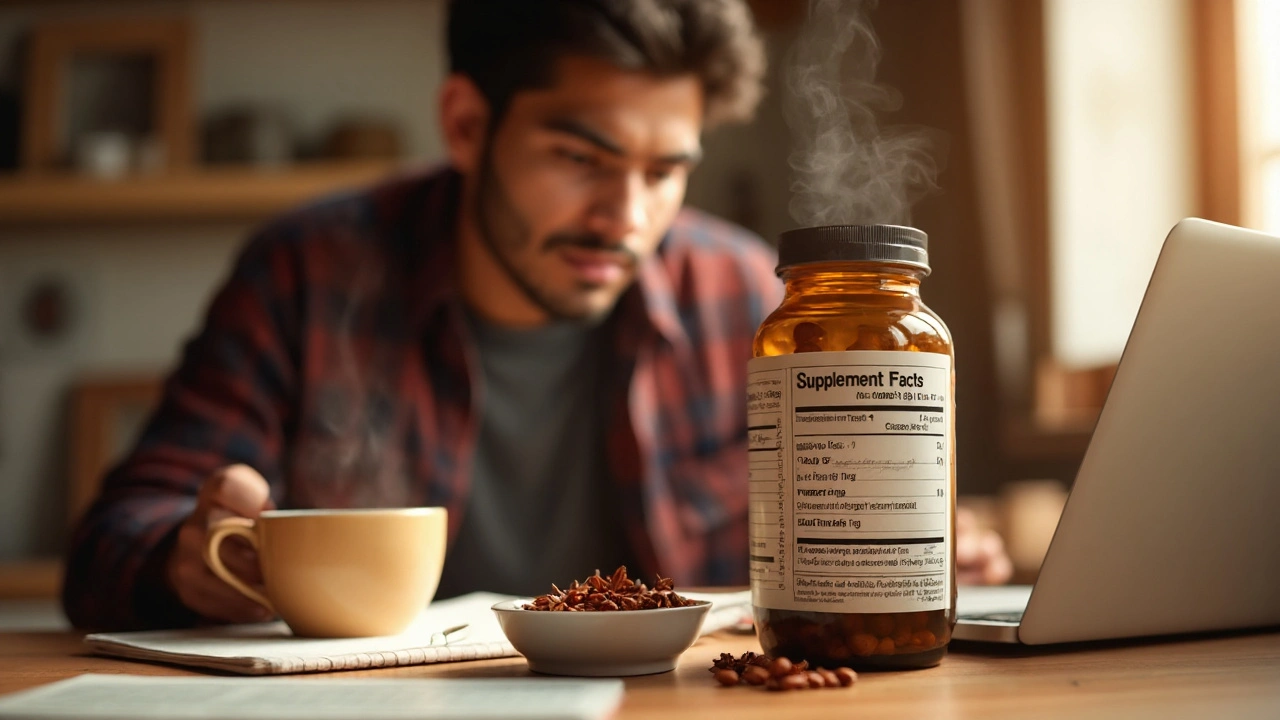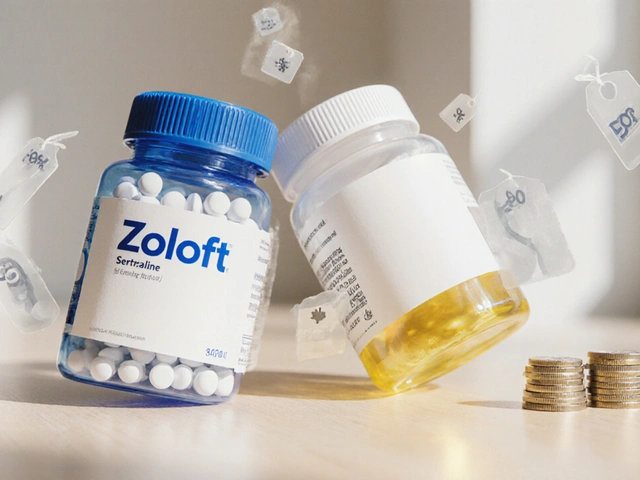You want a simple, natural way to support your immune system and dial down inflammation without turning your routine upside down. Star anise looks promising-it's the spice behind the shikimic acid used to make the flu drug oseltamivir. But supplements aren’t magic. The science says star anise can help as part of a broader plan, especially for seasonal immune support and low-grade inflammation, but it won’t replace sleep, nutrition, or your doctor’s advice. Here’s exactly how to use it safely and what to expect.
TL;DR
- Star anise (Illicium verum) contains compounds with antiviral and anti-inflammatory activity in lab and animal studies; human data is limited but encouraging for gentle immune support.
- Use food-grade fruit or standardized extracts; avoid Japanese star anise (Illicium anisatum)-it’s toxic.
- Typical adult use: 300-1,000 mg/day of extract, or tea from 1-2 whole pods up to 3 cups/day for short stretches (7-14 days).
- Skip if pregnant, breastfeeding, giving to infants, or if you use anticoagulants or have seizure disorders-talk to your clinician first.
- Best results come with basics: sleep, protein, colorful plants, vitamin D, movement, and stress control.
What star anise can (and can’t) do for immunity and inflammation
When people hear “star anise,” they think of licorice flavor and holiday mulled wine. In wellness, it’s known for shikimic acid-the same building block used to manufacture oseltamivir, a prescription flu drug. That doesn’t mean a cup of tea is the same as a pill from the pharmacy, but it explains why researchers pay attention.
What’s inside? The star-shaped fruit of Illicium verum carries shikimic acid, anethole, linalool, and polyphenols like quercetin and gallic acid. In cell and animal models, these molecules show antiviral activity (against influenza strains, coronaviruses in some in vitro setups), and they reduce inflammatory markers like TNF-α and IL-6. Reviews in Frontiers in Pharmacology (2021) and Phytotherapy Research (2022) summarize these effects, noting anti-oxidative and immune-modulating actions. A 2020 Journal of Ethnopharmacology review also highlights antimicrobial and anti-inflammatory potential from star anise extracts.
Here’s the honest part: human trials specifically on star anise fruit supplements are sparse. Most human research looks at anise seed (different plant), or uses blends. So we lean on biological plausibility plus centuries of culinary use. For practical purposes, think of star anise as a low-intensity tool to support immune readiness and calm everyday inflammation, not as a treatment for infection or autoimmune disease.
Where it shines:
- Seasonal immune support during travel, cold season, and high-stress periods.
- Soothing upper respiratory discomfort as a warm tea alongside fluids and rest.
- Background anti-inflammatory support when paired with diet and sleep improvements.
Where it’s weak:
- Treating active infections or replacing antivirals/antibiotics-don’t do that.
- Controlling serious inflammatory conditions on its own.
Safety snapshot: Culinary use is widely safe for most adults. The issues pop up with contamination (Japanese star anise is toxic) or concentrated products. The U.S. FDA documented infant reactions in the early 2000s from teas adulterated with Japanese star anise (Illicium anisatum). The European Medicines Agency and WHO monographs flag the same risk. Quality matters-more on how to avoid that below.
How to choose and use star anise safely (forms, dose, timing, combos)
Before you buy, make sure the label says Illicium verum fruit and the supplier verifies species by botanical ID testing (e.g., macroscopic, microscopic, or HPTLC). Avoid “star anise blend,” “anise tea,” or unlabeled species. Star anise is not the same as anise seed (Pimpinella anisum).
Forms you’ll see:
- Capsules/tablets: Whole-fruit powder or standardized extract (often standardized to anethole or total phenolics).
- Tincture/liquid extract: Alcohol or glycerin-based, good for quick use and flexible dosing.
- Whole pods: For tea; easy to inspect visually and smell for freshness.
- Essential oil: Aromatic only; do not ingest essential oil unless directed by a trained clinician.
Typical adult dosing (general wellness, short-term immune support):
- Capsules/extract: 300-1,000 mg/day of a quality extract, taken with food; use for 7-14 days around high-exposure periods.
- Tea: 1-2 whole pods (about 1-2 grams) per 8-10 oz hot water, steep 10 minutes, up to 2-3 cups/day for up to 14 days.
- Tincture: Common ranges are 1-2 mL, 2-3 times/day (follow your product’s label).
For everyday inflammation (stiffness after workouts, long desk days), stay on the lower end (e.g., 300-500 mg/day or 1 cup of tea) and pair it with movement and protein at meals. For “uh-oh, I feel something coming on,” nudge toward the upper end for a week, then taper.
Timing tips:
- With meals if you have a sensitive stomach.
- Evening tea works well if the warm spice helps you wind down.
- Avoid close to bedtime if you notice any restlessness-rare, but pay attention.
Smart pairings (food-first):
- Vitamin C foods (citrus, kiwi, peppers) and zinc sources (seafood, pumpkin seeds) for immune synergy.
- Curcumin or ginger for anti-inflammatory support-take with fats for better absorption.
- Vitamin D status in range (ask your clinician for a 25(OH)D test) correlates with immune resilience.
Who should skip or get medical clearance first:
- Pregnant or breastfeeding individuals; do not give to infants or toddlers.
- Anyone with seizure disorders, liver disease, or unexplained neurologic symptoms.
- People on anticoagulants/antiplatelets, or with bleeding disorders (limited data; better to be cautious).
- Known allergies to Illicium species or severe spice sensitivities.
Possible side effects: mild nausea, stomach upset, headache, skin rash. If you notice agitation, tremor, or neurologic symptoms, stop immediately-contamination is possible-and seek care.
Quality checklist (quick scan on the label or website):
- Botanical name: Illicium verum (fruit), country of origin disclosed.
- Species testing: states ID methods (at least botanically authenticated).
- Contaminant testing: heavy metals, pesticides, microbial counts, and species adulteration.
- Standardization: e.g., percent anethole or total phenolics (not required, but helpful for consistency).
- Third-party certifications: USP, NSF, ISO-accredited lab testing, or equivalent.
How I like to start clients: a 7-10 day “immune window” protocol during travel season. Day 1-3: tea twice daily or 500 mg extract once daily. Day 4-10: keep one serving per day. Then stop and watch how you feel for a week.
| Form | Typical Dose | Best For | Pros | Cons | Approx. Cost (Month, 2025) |
|---|---|---|---|---|---|
| Capsule (extract) | 300-1,000 mg/day | Travel, consistent dosing | Easy, standardized, portable | Quality varies; read labels | $12-$25 (60-90 caps) |
| Tincture | 1-2 mL, 2-3x/day | Flexible dosing, quick start | Fast absorption, easy to stack with tea | Taste, alcohol base for some | $10-$18 (30-60 mL) |
| Whole pods (tea) | 1-2 pods/cup, up to 3 cups/day | Comfort, hydration, culinary use | Inexpensive, aromatic, versatile | Variable strength; needs time | $6-$12 (4-8 oz) |
| Essential oil | Topical/aroma only | Steam inhalation, scent | Potent aroma | Do not ingest; can irritate skin | $8-$16 (10-15 mL) |

Step-by-step: build your plan (with checklists, examples, and pitfalls)
Job 1: Quick immune tune-up (travel week, cold season)
- Pick your form: 500 mg standardized extract or tea.
- Start 2-3 days before travel: 500 mg with breakfast, or tea morning and evening.
- During the high-risk window (airports, big events): keep one serving daily and add vitamin C foods at each meal.
- Hydrate, sleep 7-9 hours, walk outside daily.
- Stop after 7-10 days and reassess.
Job 2: Calm everyday inflammation (tight shoulders, desk stiffness)
- Use a low dose: 300-500 mg extract or 1 cup of tea daily for 2-3 weeks.
- Pair with 20-30 g protein per meal and 10 minutes of mobility work.
- Track what matters: morning stiffness (0-10), energy, and sleep. Adjust after 14-21 days.
Job 3: Support when you feel that first tickle
- At first signs, take a warm tea (2 pods, 10-minute steep) and rest. Consider honey and ginger.
- If you prefer capsules, 500-1,000 mg/day for 5-7 days with food.
- If symptoms escalate or linger, contact your clinician-don’t self-treat serious illness.
Buying checklist (print this):
- Illicium verum clearly stated? Yes/No
- Species testing and contaminant screening mentioned? Yes/No
- Country of origin and batch/lot number listed? Yes/No
- Standardized extract or clear serving size? Yes/No
- Third-party testing badge (USP/NSF/ISO lab)? Yes/No
Brewing guide for a steady, soothing cup:
- Light immune tea: 1 pod, 8-10 oz hot water, 10 minutes covered.
- Stronger tea: 2 pods; add a slice of ginger and lemon.
- Cold-brew option for sensitive stomachs: 2 pods in 12 oz cool water, steep 2-3 hours, strain, warm gently.
Pitfalls to avoid:
- Unlabeled “anise tea” blends-may contain the wrong plant.
- Taking essential oil by mouth-don’t.
- Using it for weeks on end without breaks; cycle it (1-3 weeks on, then off).
- Skipping the basics (sleep, protein, hydration) and expecting a spice to do all the work.
Realistic expectations and how to measure:
- Immune support shows up as “I bounced back faster” or “I didn’t crash after that trip,” not as superpowers.
- Inflammation support can feel like milder morning stiffness or less throat scratchiness with your usual triggers.
- Track 2-3 simple markers for two weeks: daily energy (0-10), morning stiffness (0-10), number of sniffly days.
Answers you’re looking for (FAQ) + next steps
Is star anise the same as anise seed? No. Star anise is Illicium verum (a star-shaped fruit from an evergreen tree). Anise seed is Pimpinella anisum (a seed from the parsley family). They taste similar due to anethole but they’re different plants with different research.
Can it prevent the flu? No supplement can promise that. Lab data shows antiviral activity, and shikimic acid is used industrially to make antivirals, but taking star anise isn’t the same as taking a prescription. Think “support,” not “prevention.”
Is there human research? Direct, high-quality human trials on star anise fruit supplements are limited. Reviews in 2020-2023 summarize mostly lab and animal studies showing immune and anti-inflammatory mechanisms. That’s why I recommend it as a gentle, short-term add-on, not a standalone therapy.
What about long-term daily use? I don’t recommend continuous daily use. Use it in 1-3 week blocks around higher-risk times or as-needed for comfort, then take a break. Rotate with other spices (ginger, cinnamon) and focus on diet and sleep.
Does it interact with medications? Data is limited, but out of caution, avoid with anticoagulants/antiplatelets and talk to your clinician if you take seizure meds, sedatives, or have liver disease. Space it 2 hours away from prescriptions to avoid absorption issues.
Is it safe in pregnancy or while breastfeeding? Skip it unless your obstetric provider says otherwise. Do not give star anise tea or products to infants-there have been reports of serious reactions from contaminated teas.
How do I know it’s the right species? The label must list Illicium verum and the part (fruit). Reputable brands show species testing. Whole pods should be star-shaped, reddish-brown, with a warm, sweet aroma-not bitter or camphor-like.
What if I’m sensitive to spices? Start low: one small cup of tea (1 pod) every other day. If you notice any irritation, stop. Consider other gentle supports like ginger tea or chamomile.
Can I use it with vitamin C, D, or zinc? Yes, that’s common. Keep zinc to 15-30 mg/day short-term and check your vitamin D level with your clinician to personalize dosing.
Is the essential oil useful? For scent or steam inhalation, sure. Do not ingest it. If used topically, dilute it well and patch test to avoid skin irritation.
Next steps based on your scenario:
- If you’re traveling: Pack capsules (500 mg) and brew bags with two crushed pods in a zip bag. Start 2 days before you fly.
- If you’re managing desk-related aches: Low-dose tea after lunch, plus a 10-minute stretch. Reassess in 2 weeks.
- If you’re on medications: Bring the bottle to your pharmacist; ask, “Any interaction concerns with Illicium verum fruit extract at 300-500 mg/day?”
- If you have a sensitive gut: Try cold-brew tea and take with food; avoid tinctures with alcohol.
- If you want a food-first approach: Add one pod to stews, broths, or chai 3-4 times/week instead of daily supplements.
Troubleshooting:
- Stomach upset: Cut the dose in half, take with food, or switch from tincture to tea.
- No noticeable effect after 10 days: You may not need it, or the dose is too low. Reassess sleep, protein (aim ~1.2-1.6 g/kg/day), and stress.
- Jittery or wired feeling: Stop and review the product-possible adulteration. Choose a tested brand.
Why I trust it (within reason): Decades of culinary safety plus lab evidence of antiviral and anti-inflammatory actions make star anise supplements a reasonable short-term tool. The key is smart sourcing, modest dosing, and using it to support-not replace-your basics.
Key sources I rely on: Frontiers in Pharmacology (2021) review on Illicium phytochemistry; Phytotherapy Research (2022) on anti-inflammatory mechanisms; Journal of Ethnopharmacology (2020) on traditional uses and modern data; regulatory notes from the FDA and European agencies on Japanese star anise toxicity and the need for species verification.






Written by Martha Elena
I'm a pharmaceutical research writer focused on drug safety and pharmacology. I support formulary and pharmacovigilance teams with literature reviews and real‑world evidence analyses. In my off-hours, I write evidence-based articles on medication use, disease management, and dietary supplements. My goal is to turn complex research into clear, practical insights for everyday readers.
All posts: Martha Elena